ISO 25539-2 Vascular Stent Dimensional Accuracy Testing
The ISO 25539 series of standards provides comprehensive guidelines for the testing of vascular stents, ensuring their dimensional accuracy and compliance with medical device regulations. These standards are particularly critical in the realm of cardiac and cardiovascular devices, where even minor deviations can have significant clinical implications.
ISO 25539-2 specifically addresses the measurement and evaluation of geometrical parameters of vascular stents. This service is essential for quality assurance, compliance with regulatory requirements, and ensuring product reliability before market release. The test involves precise measurement techniques to evaluate various dimensions such as length, diameter, and expanded cross-sectional area.
The testing process begins with careful preparation of the sample, which must be representative of the production batch. Instruments used include coordinate measuring machines (CMM), laser scanners, and digital calipers, all calibrated according to international standards. The test procedure involves multiple stages: initial setup, measurement, data collection, and analysis.
The accuracy of these measurements is crucial as they directly impact patient safety and the efficacy of medical devices. For instance, improper dimensioning can lead to complications such as stent migration or thrombosis, both of which are serious issues in cardiovascular interventions. By adhering strictly to ISO 25539-2, manufacturers ensure that their products meet stringent regulatory requirements.
The results from this testing are critical for product development and continuous improvement. They inform design iterations, material selection, and manufacturing processes, ultimately leading to safer and more effective medical devices. Regulatory bodies like the FDA (United States) and the CE marking process in Europe rely heavily on such tests to ensure that products entering the market meet safety and performance standards.
Moreover, this testing service supports research and development activities by providing accurate baseline data for new product designs. It also aids in troubleshooting manufacturing issues, ensuring consistent quality across production batches. In essence, ISO 25539-2 dimensional accuracy testing is a cornerstone of the cardiac and cardiovascular device industry's commitment to patient safety and regulatory compliance.
| Measurement Point | Description | Unit of Measurement | Data Collection Method |
|---|---|---|---|
| Length | The overall length of the stent from start to finish. | Millimeters (mm) | CMM and laser scanning |
| Diameter | The inner diameter at various axial positions. | Micrometers (µm) | Laser scanning and calipers |
| Expanded Cross-Sectional Area | Total area of the expanded stent, including any deformities. | Square millimeters (mm²) | CMM and laser scanning |
Industry Applications
Vascular stents are integral components in the treatment of coronary artery disease, peripheral artery disease, and other cardiovascular conditions. ISO 25539-2 dimensional accuracy testing is widely used across various sectors within the medical device industry:
| Sector | Description of Application | Type of Vascular Stents Tested |
|---|---|---|
| Catheterization Laboratories | Testing stents used in angioplasty procedures. | Braided, expandable nitinol stents |
| Cardiovascular Surgery Centers | Evaluating stents for use during bypass surgery. | Tubular, self-expanding polymeric stents |
| Vascular Access Units | Assessing stents used in dialysis access. | Coiled, expandable stainless steel stents |
Why Choose This Test
The ISO 25539-2 dimensional accuracy testing service is indispensable for several reasons. Firstly, it ensures that all stents meet the stringent requirements set by regulatory bodies and industry standards. Secondly, it enhances product quality and safety, reducing the risk of adverse events in patients. Thirdly, this test provides valuable insights into manufacturing processes, enabling continuous improvement and innovation.
By adhering to ISO 25539-2, manufacturers can demonstrate compliance with international standards, which is essential for gaining market access in countries like the United States, Europe, and Asia. This testing service also supports clinical trials by providing accurate baseline data necessary for regulatory submissions. Furthermore, it helps companies maintain a competitive edge by ensuring that their products are among the best-in-class.
The precision of ISO 25539-2 dimensional accuracy testing is particularly important given the sensitive nature of cardiovascular devices. Even small deviations in dimensions can lead to significant clinical issues. By leveraging this service, medical device companies can ensure that their products are reliable and safe, thereby building trust with healthcare providers and patients.
In summary, ISO 25539-2 dimensional accuracy testing is a critical component of the quality assurance process in the cardiac and cardiovascular device industry. It not only ensures regulatory compliance but also enhances product performance and safety, ultimately contributing to better patient outcomes.
Competitive Advantage and Market Impact
The ISO 25539-2 dimensional accuracy testing service offers several competitive advantages that can significantly impact market positioning. By ensuring that products meet the highest standards of quality and safety, companies can differentiate themselves in a crowded market. Regulatory compliance is a key factor that influences patient trust and physician preference.
Compliance with international standards such as ISO 25539-2 also opens up new markets and opportunities for expansion. Companies that demonstrate their commitment to quality through rigorous testing are more likely to receive favorable reviews from regulatory bodies, which can lead to faster approvals and greater market acceptance.
The precision and reliability of the test results provided by this service can also enhance brand reputation. When patients trust the products they use, it reflects positively on the company's overall image. This trust is crucial for maintaining long-term relationships with healthcare providers and patients.
Furthermore, continuous improvement in manufacturing processes, driven by accurate test data, can lead to innovations that set new industry benchmarks. By staying ahead of the curve in terms of quality and performance, companies can maintain a competitive edge and attract top talent within the sector.
In conclusion, ISO 25539-2 dimensional accuracy testing is not just a compliance requirement; it is a strategic investment that enhances product quality, supports regulatory success, builds market trust, and drives innovation. This service equips companies with the tools they need to thrive in a constantly evolving medical device landscape.





